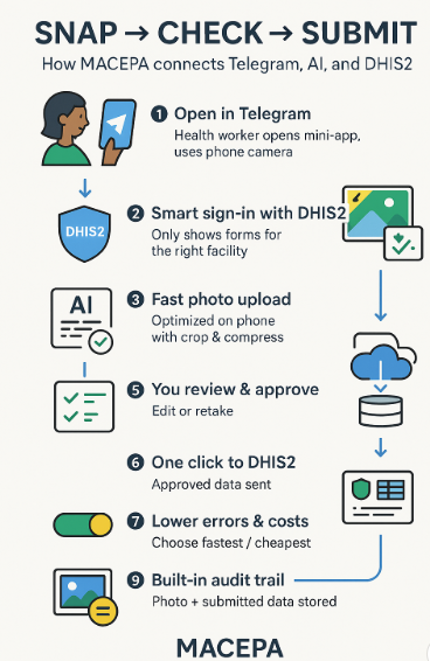PATH has developed a new digital tool called SnapForm which improves efficiency and accuracy of health data reporting in settings with high volumes of paper-based reporting. The tool utilizes artificial intelligence (AI) to read data from paper registers and match it to the correct reporting data entry box in national health information systems.
Compared to contemporary methods of reporting, early evaluations of SnapForm suggest that the tool reduces transcription errors by 50%, cuts reporting times by 90%, and doubles data completeness.
The problem
Timely and accurate health data reporting is essential to monitoring disease trends, identifying surges and outbreaks, and decision-making at local and national levels.
Yet in many resource-constrained contexts, such as the Democratic Republic of the Congo (DRC), entry of health service and surveillance data captured on paper and entered manually into national data systems is time- and labor-intensive and often contributes to inaccuracies in the health data available to decision-makers.
In the DRC, health zone staff process 30 to 150 health facility Health Management Information System (HMIS) reports a month—this includes manually entering approximately 2,000 data points per health facility into the digital health reporting platform, DHIS2.
Across the country, this amounts to around half a million pages of health reports entered into DHIS2 every month. Manual entry of data is time and labor-intensive, leading to delays in reporting, high risk of data entry error, and limited verification of data quality prior to submission.
A malaria data quality audit in the DRC conducted in partnership with health facility and health zone staff in 2021-2022 found that only 20% of malaria data were accurately reported into national systems.
The solution
With support from the Gates Foundation, PATH’s Malaria Control and Elimination Partnership (MACEPA) has developed SnapForm, a tool that operates within Telegram, an app that health zone workers regularly use, and that uses AI to read data from paper reports and match it to reports in DHIS2, accelerating data entry and processing time and improves data accuracy.
Health zone staff use a mini-app within Telegram to snap pictures of health facility registers, and the program sends the images to an external AI. The photo is parsed, and the data are read and matched to the correct entry line in DHIS2. The user reviews and verifies the AI-generated results prior to submitting to DHIS2.
Most health zone staff already use Telegram and are familiar with the platform, requiring no new software for health zone staff to adapt SnapForm. The mini-app within Telegram prompts the user to sign into their DHIS2 account where they are shown a customized interface with information specific to the staff member and health zone.
Currently, SnapForm can only be used while connected to the internet, but SnapForm creator Belendia Serda and the innovation and delivery team—Vera Krylova, Jicko Bondole, and Caterina Guinovart—are developing an offline version, allowing end-users to take photos of registers at any time that the app can store until connected to the internet for submission.
The MACEPA team worked closely on the development of SnapForm with stakeholders at multiple levels including the DRC HMIS and Ministry of Health staff as well as end-users at the facility level. Close collaboration was essential to ensure that the application could easily integrate into health worker workflows and would result in accurate transfer of facility data into existing national health data management systems.
SnapForm was piloted in 12 DRC health zones for several months and has demonstrated improved efficiency through substantially reducing time needed to report data: reporting that once took a facility health worker more than two hours to complete can now be completed in about 15 minutes. Initial experience with SnapForm has also demonstrated that SnapForm can double the accuracy of data reported from facilities into the national system.
Many health systems in Africa rely on health workers to manually enter facility data from paper registers into national HMIS—a routine activity requiring an immense amount of effort undertaken in the context of major resource constraints and human resource shortages.
The experience in the DRC suggests that SnapForm could be an important tool to gain efficiency and improve accuracy of health data reporting in these settings in support of better data to improve public health planning and preparedness.


